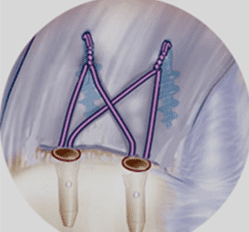A patient with severe rotator cuff injury requiring surgical treatment. Before the operation, the doctor prescribed a list of spare materials for the operation, including seven or eight anchors, which were used to repair the rotator cuff and fix the tendons. The patient is a little confused, does it have to use many anchors for rotator cuff repair?
Evolution of Rotator Cuff Repair Methods
This needs to start with the evolution of rotator cuff repair methods. In the past, the classic method of rotator cuff repair was arthrotomy: a bone tunnel was made at the greater tuberosity of the humeral head, sutures were inserted into the bone tunnel, and then the sutures were used to pull the broken and retracted rotator cuff back to the humeral head. The large nodule area. The surgery at this time does not require anchors, only sutures are used to reduce and fix the rotator cuff. This repair method is called transosseous suture repair.

At this stage 20 to 30 years ago, rotator cuff repair methods experienced a transformation from incisional surgery to arthroscopic surgery. The surgery at that time was called arthroscopically assisted surgery, which used arthroscopic technology to perform some minimally invasive operations, and ultimately the surgery had to be completed through a mini-open. This stage is when arthroscopic technology gradually matures. As for the method of rotator cuff repair, we will first try to repair it with threaded anchors. If the operation cannot be completed with threaded anchors, we will eventually rely on transosseous suture repair method.
In the past 20 years, due to the development and maturity of arthroscopic rotator cuff repair equipment and the maturity of arthroscopic surgical techniques, rotator cuff repair has surpassed the mini-open stage and become a complete arthroscopic repair. At present, the standard arthroscopic rotator cuff repair is to use a threaded anchor repair method: first nail the threaded anchor at the greater tuberosity of the humerus, then use the thread on the anchor to pass through the torn rotator cuff, and finally Pull it back to the greater tuberosity of the humerus and fix it.

Shift in Anchor Usage
Methods of rotator cuff repair using wired anchors are also changing. The early repair method was called single-row repair, which used a row of anchors to pull back the rotator cuff. In this way, although the rotator cuff is pulled back to the humeral head, the contact area with the humeral head is small, which is far inferior to the past joint incision and transosseous suture repair. In the end, the healing of the rotator cuff is also compromised.
In recent years, a new technology using threaded anchors to repair the rotator cuff has emerged, which is called bone-piercing technology. Generally, 2 rows of anchors are used: first, use the thread on the inner row of anchors to pass through the rotator cuff as medially as possible to reset the rotator cuff; then use the outer row of anchors to press down the sutures together with the rotator cuff, which can fully increase the shoulder tension. The contact area between the sleeve and the greater tuberosity of the humerus has an effect similar to that of past arthrotomy transosseous suture repairs, so it becomes a quasi-transosseous technique.
From the perspective of biomechanics and clinical repair effect of the rotator cuff, the transosseous technique has obvious advantages over the single-row anchor repair technique. The above-mentioned patients have more spare anchors, usually in preparation for transosseous double-row rotator cuff repair.

Because of the wired anchor, conventional rotator cuff repair can be completed under arthroscopy, achieving the goal of minimally invasive arthroscopy. However, there are certain problems with using anchors to repair the rotator cuff. The biggest problem is that if the patient has osteoporosis, the anchor can easily be pulled out of the bone, causing the repair to fail.
Reconsiderations for the Surgical Approach
Patients with rotator cuff injuries mostly occur in the elderly. They already have systemic osteoporosis and a corresponding decrease in bone density in the shoulder joint. In addition, some studies have shown that after the rotator cuff is completely ruptured, if it is not repaired in time, osteoporosis will worsen in the shoulder joint, which is called disuse bone atrophy, making it more difficult to repair the rotator cuff.
For osteoporosis in the shoulder joint, doctors will use some methods to avoid it. For example, when implanting anchors, select areas with higher bone density, use larger anchors, and use specially designed anchors with high pullout resistance. However, in severe osteoporosis, these methods may not prevent the anchor from being pulled out.
Because for patients with shoulder osteoporosis, repair with threaded anchors is unreliable, and transosseous suture repair is required. Arthroscopic transosseous suture repair is more complicated and time-consuming than thread anchor repair. If a skilled sports medicine or arthroscopic surgeon can complete an arthroscopic quasi-transosseous repair with thread anchors within 90 minutes, it will generally take 2 to complete a true transosseous suture repair under arthroscopic surgery. Hour.
For patients without obvious osteoporosis, it is recommended to use conventional transosseous repair surgery with thread anchors. Although this surgery requires tens of thousands of yuan in material costs, it saves surgery time. Because shoulder arthroscopy is performed under general anesthesia with blood pressure lowered to the lowest limit (to reduce intraoperative bleeding in the surgical field), an additional half-hour of operation time also increases the risk of cerebral ischemia by half an hour. However, for patients with obvious osteoporosis, the rigid use of anchor repair will cause surgical failure, so it is worthwhile to use a more complex surgery – arthroscopic transosseous repair.
So, is it necessary to use anchors for rotator cuff repair? The answer is: if there is no severe shoulder osteoporosis, it is best to use anchors to save surgical time; if there is severe shoulder osteoporosis, the use of anchors is contraindicated, and arthroscopic transosseous repair technology needs to be used.